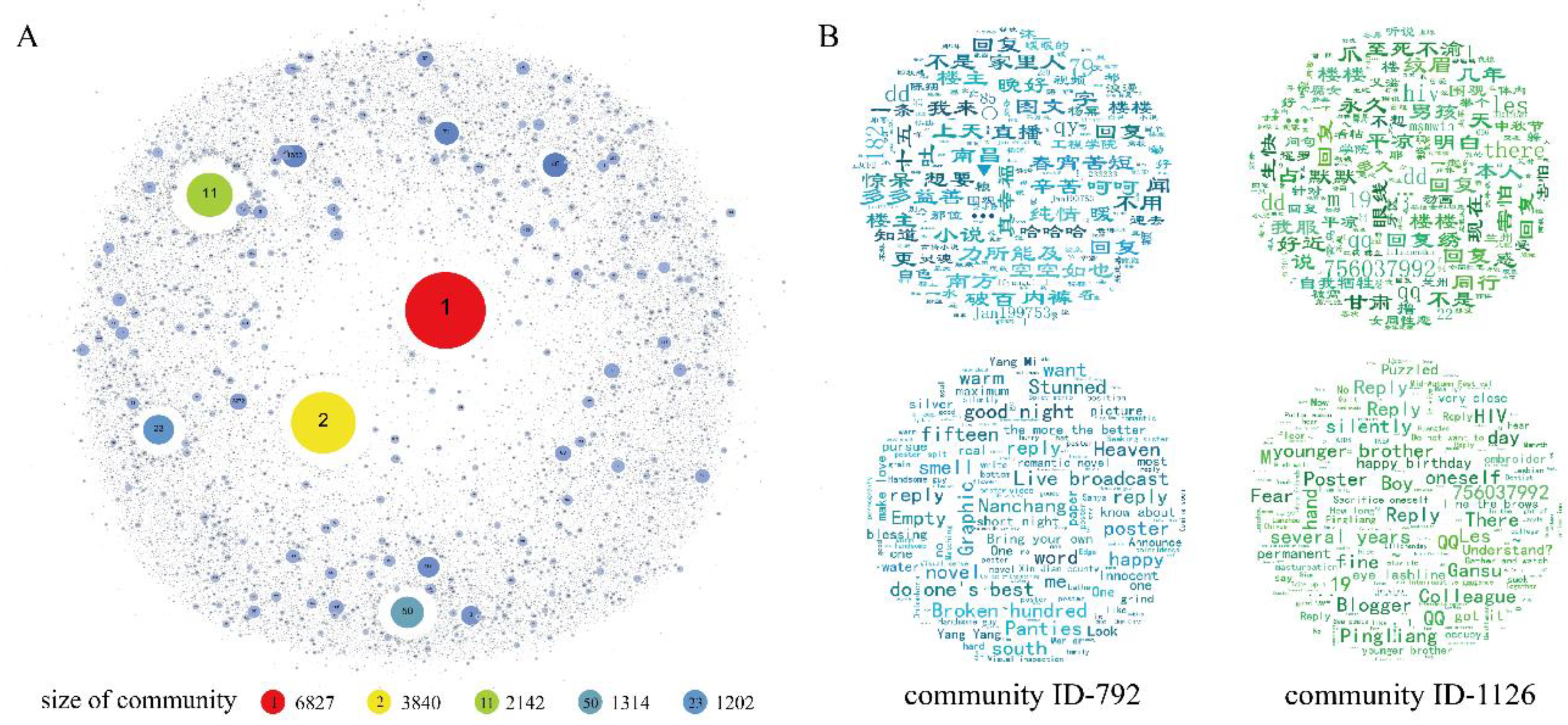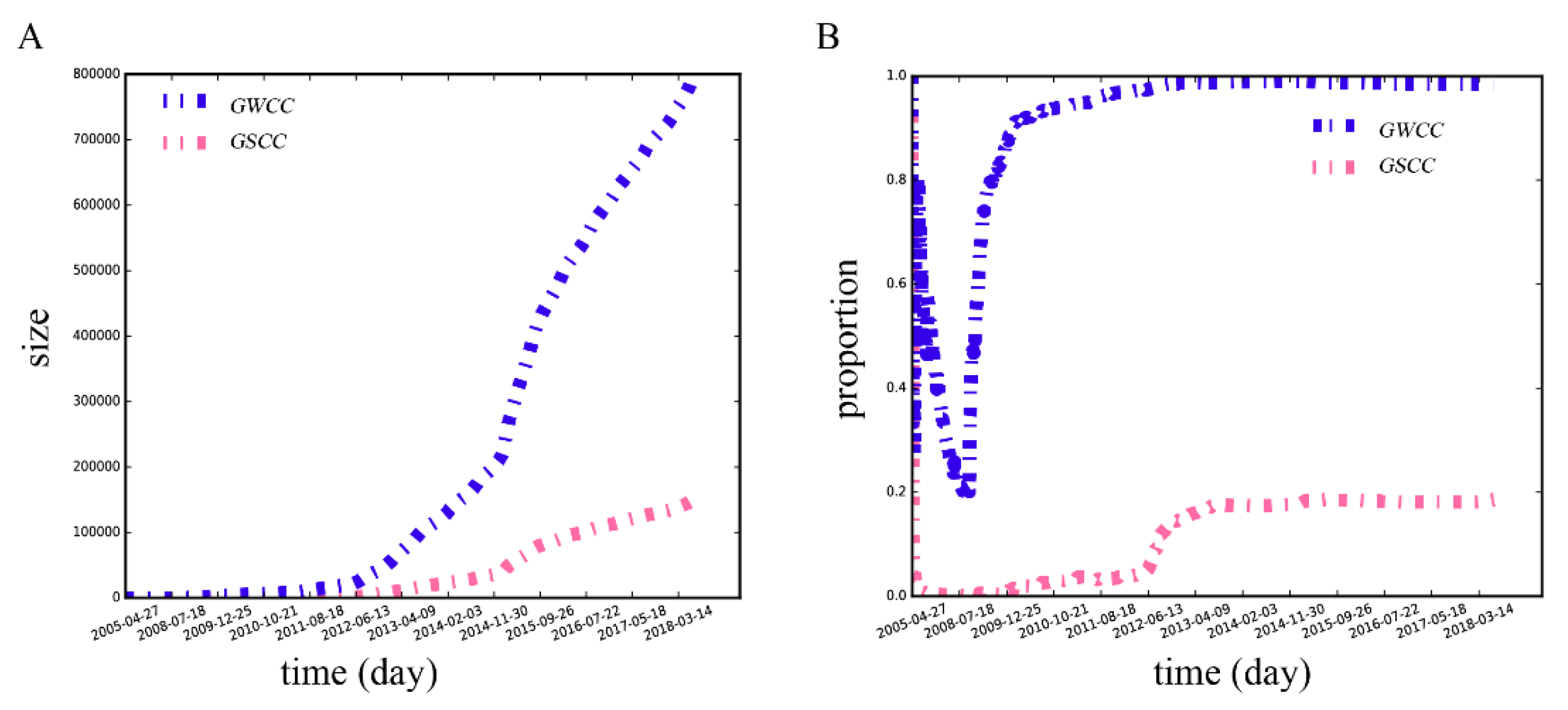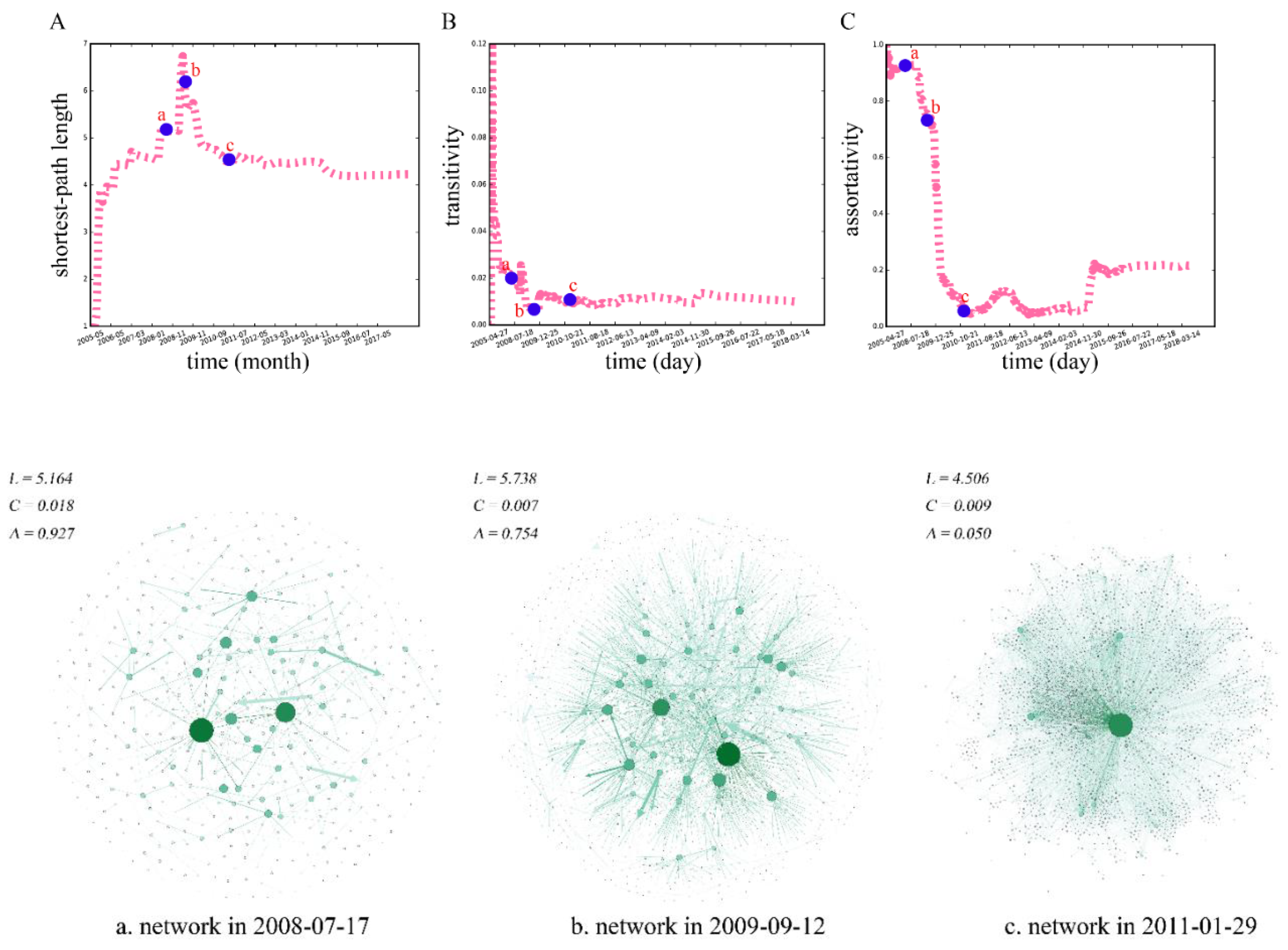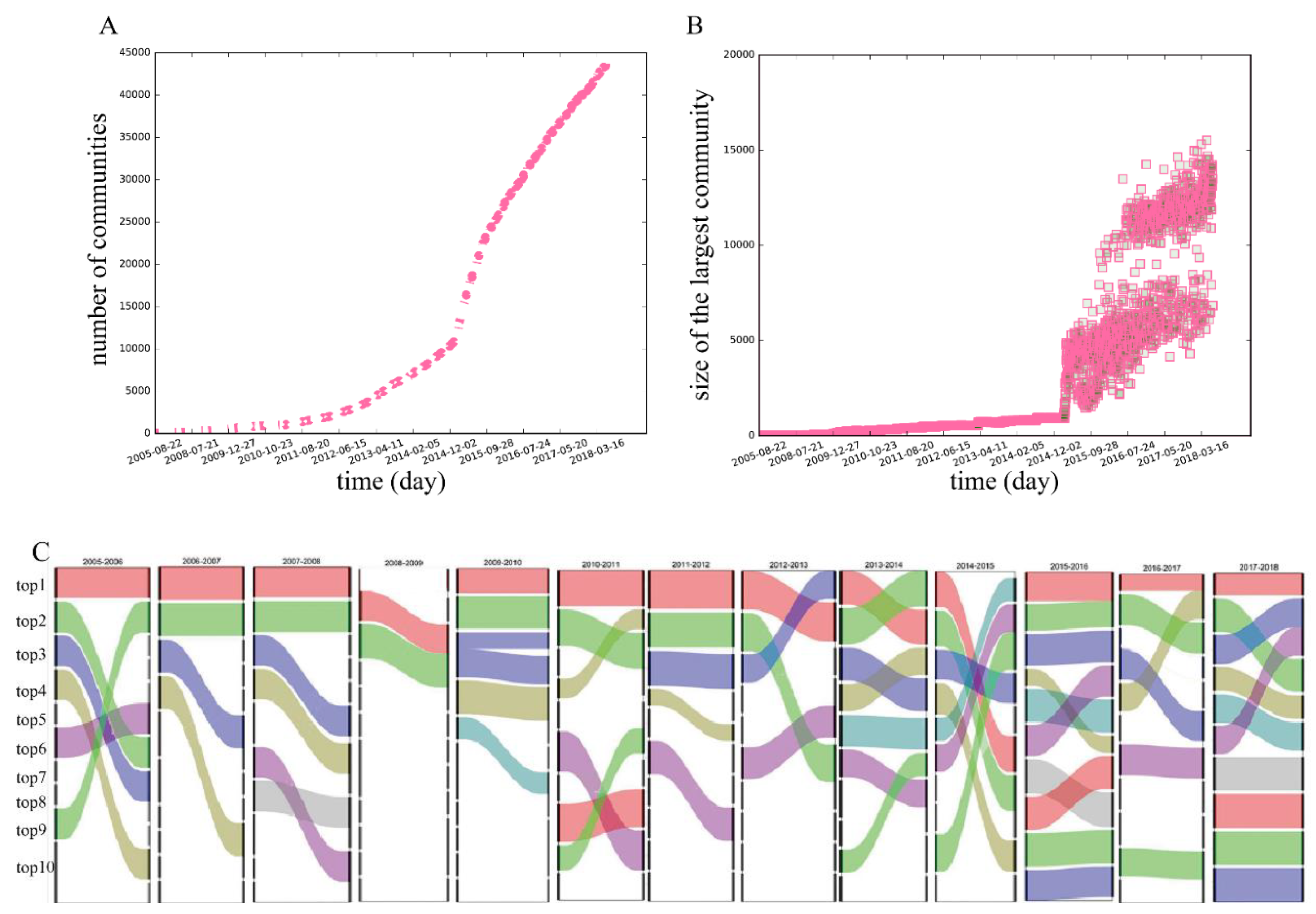Network Evolution of a Large Online MSM Dating Community: 2005–2018
Abstract
1. Introduction
2. Data and Methods
2.1. Ethics Approval and Consent to Participate
2.2. Data Availability
3. Results
3.1. Static Network Analysis
3.1.1. Basic Network Statistics
3.1.2. Degree Distribution and Number of Posts
3.1.3. Distribution of the Edge Weights
3.1.4. Homophily
3.1.5. Community Analysis of the MSM Dating Network
3.2. Temporal Evolution Pattern of the MSM Dating Network
3.2.1. Dynamics of Nodes and Edges
3.2.2. Dynamics of the Giant Strongly and Weakly Connected Components
3.2.3. Shortest-Path Length
3.2.4. Clustering
3.2.5. Assortativity
3.2.6. Community
4. Discussion and Conclusions
Author Contributions
Funding
Conflicts of Interest
References
- Ofosu, E.K.; Chambers, M.K.; Chen, J.M.; Hehman, E. Same-sex marriage legalization associated with reduced implicit and explicit antigay bias. Proc. Natl. Acad. Sci. USA 2019, 116, 8846–8851. [Google Scholar] [CrossRef] [PubMed]
- Erickson, T. Legalization of Gay Marriage-United States Supreme Court Declares It Unconstitutional for States to Deny Same-Sex Couples the Right to Marry: Immediate Impact of Gay Marriage in North Dakota. NDL Rev. 2015, 91, 219. [Google Scholar]
- Veronese, V.; Clouse, E.; Wirtz, A.L.; Thu, K.H.; Naing, S.; Baral, S.D.; Stoové, M.; Beyrer, C. “We are not gays… don’t tell me those things”: engaging ‘hidden’ men who have sex with men and transgender women in HIV prevention in Myanmar. BMC public health. 2019, 19, 63. [Google Scholar] [CrossRef] [PubMed]
- Cao, H.; Zhou, N.; Fine, M.; Liang, Y.; Li, J.; Mills-Koonce, W.R. Sexual minority stress and same-sex relationship well-being: A meta-analysis of research prior to the uS Nationwide legalization of same-sex marriage. J. Marriage Fam. 2017, 79, 1258–1277. [Google Scholar] [CrossRef]
- Chu, Z.; Xu, J.; Zhang, Y.; Zhang, J.; Hu, Q.; Yun, k.; Wang, H.; Jiang, Y.; Geng, W.; Shang, H. Poppers use and Sexual Partner Concurrency Increase the HIV Incidence of MSM: a 24-month Prospective Cohort Survey in Shenyang, China. Sci. Rep. 2018, 8, 24. [Google Scholar] [CrossRef]
- Jie, W.; Ciyong, L.; Xueqing, D.; Hui, W.; Lingyao, H. A syndemic of psychosocial problems places the MSM (men who have sex with men) population at greater risk of HIV infection. PLoS ONE 2012, 7, e32312. [Google Scholar] [CrossRef]
- Berghe, W.V.; Nöstlinger, C.; Hospers, H.; Laga, M. International mobility, sexual behaviour and HIV-related characteristics of men who have sex with men residing in Belgium. BMC Public Health. 2013, 13, 968. [Google Scholar]
- Guanghua, L.; Yi, C.; Shuai, T.; Zhiyong, S.; Zhenzhu, T.; Yuhua, R.; Yousuf, M.A.; Wensheng, F. HIV, syphilis and behavioral risk factors among men who have sex with men in a drug-using area of southwestern China: Results of 3 cross-sectional surveys from 2013 to 2015. Medicine. 2018, 97, e0404. [Google Scholar] [CrossRef]
- Chow, E.P.F.; Wilson, D.P.; Zhang, J.; Jing, J.; Zhang, L. Human immunodeficiency virus prevalence is increasing among men who have sex with men in China: findings from a review and meta-analysis. STI 2011, 38, 845–857. [Google Scholar] [CrossRef]
- Beyrer, C.; Baral, S.D.; Van Griensven, F.; Goodreau, S.M.; Chariyalertsak, S.; Wirtz, A.L.; Brookmeyer, R. Global epidemiology of HIV infection in men who have sex with men. Lancet 2012, 380, 367–377. [Google Scholar] [CrossRef]
- A Joint Assessment of HIV/AIDS Prevention, Treatment and Care in China. Available online: http://data.unaids.org/una-docs/china_joint_assessment_2003_en.pdf (accessed on 22 July 2019).
- Qi, J.; Zhang, D.; Fu, X.; Li, C.; Meng, S.; Dai, M.; Liu, H.; Sun, J. High risks of HIV transmission for men who have sex with men—a comparison of risk factors of HIV infection among MSM associated with recruitment channels in 15 cities of China. PLoS ONE 2015, 10, e0121267. [Google Scholar] [CrossRef] [PubMed]
- Wong, H.T.H.; Tam, H.Y.; Chan, D.P.C.; Lee, S.S. Usage and acceptability of HIV self-testing in men who have sex with men in Hong Kong. AIDS Behav. 2015, 19, 505–515. [Google Scholar] [CrossRef] [PubMed]
- Ncaids, N. Update on the AIDS/STD epidemic in China and main response in control and prevention in December, 2015. Chin. J. AIDS STD. 2016, 22, 69. [Google Scholar]
- Lu, X. Respondent-Driven Sampling: Theory, Limitations & Improvements; Inst för folkhälsovetenskap/Dept. of Public Health Sciences: Stockholm, Sweden, 2013. [Google Scholar]
- Lu, X.; Malmros, J.; Liljeros, F.; Britton, T. Respondent-driven sampling on directed networks. Electron. J. Statist. 2013, 7, 292–322. [Google Scholar] [CrossRef]
- Lu, X.; Brelsford, C. Network structure and community evolution on twitter: human behavior change in response to the 2011 Japanese earthquake and tsunami. Sci. Rep. 2014, 4, 6773. [Google Scholar] [CrossRef]
- Lu, X.; Bengtsson, L.; Britton, T.; Camitz, M.; Kim, B.J.; Thorson, A.; Liljeros, F. The sensitivity of respondent-driven sampling. J. R. Stat. Soc. Ser. A. Stat. Soc. 2012, 175, 191–216. [Google Scholar] [CrossRef]
- Pilon, R.; Leonard, L.; Kim, J.; Vallee, D.; Rubeis, E.D.; Jolly, A.M.; Wylie, j.; Peludel, .; Sandstrom, P. Transmission patterns of HIV and hepatitis C virus among networks of people who inject drugs. PLoS ONE 2011, 6, e22245. [Google Scholar] [CrossRef]
- Baltar, F.; Brunet, I. Social research 2.0: virtual snowball sampling method using Facebook. Internet Res. 2012, 22, 57–74. [Google Scholar] [CrossRef]
- Coursaris, C.K.; Liu, M. An analysis of social support exchanges in online HIV/AIDS self-help groups. Comput. Human Behav. 2009, 25, 911–918. [Google Scholar] [CrossRef]
- Macapagal, K.; Coventry, R.; Puckett, J.A.; Phillips, G. II; Mustanski, B. Geosocial networking app use among men who have sex with men in serious romantic relationships. Arch. Sex. Behav. 2016, 45, 1513–1524. [Google Scholar] [CrossRef]
- Bien, C.H.; Best, J.M.; Muessig, K.E.; Wei, C.; Han, L.; Tucker, J.D. Gay apps for seeking sex partners in China: implications for MSM sexual health. AIDS Behav. 2015, 19, 941–946. [Google Scholar] [CrossRef] [PubMed]
- Young, L.E.; Michaels, S.; Jonas, A.; Khanna, A.S.; Skaathun, B.; Morgan, E.; Schneider, J.A. Sex behaviors as social cues motivating social venue patronage among young black men who have sex with men. AIDS Behav. 2017, 21, 2924–2934. [Google Scholar] [CrossRef]
- Rice, E.; Holloway, I.; Winetrobe, H.; Rhoades, H.; Barman-Adhikari, A.; Gibbs, J.; Carranza, A.; Dent, D.; Dunlap, S. Sex risk among young men who have sex with men who use Grindr, a smartphone geosocial networking application. J. AIDS Clinic. Res. 2012. [Google Scholar] [CrossRef]
- Bolding, G.; Davis, M.; Hart, G.; Sherr, L.; Elford, J. Gay men who look for sex on the Internet: is there more HIV/STI risk with online partners? Aids 2005, 19, 961–968. [Google Scholar] [CrossRef] [PubMed]
- Shiyao, X. Analysis of HIV high-risk population characteristics with Baidu Tieba data. Big Data Res. 2019, 5, 98–108. [Google Scholar]
- Wu, Z.; Xu, j.; Liu, E.; Mao, Y.; Xiao, Y.; Sun, X.; Liu, Y.; Jiang, Y.; McGoogan, J.M.; Dou, Z.; et al. HIV and syphilis prevalence among men who have sex with men: a cross-sectional survey of 61 cities in China. Clin. Infect. Dis. 2013, 57, 298–309. [Google Scholar] [CrossRef]
- Valente, T.W.; Pitts, S.R. An appraisal of social network theory and analysis as applied to public health: challenges and opportunities. Annu. Rev. Public Health 2017, 38, 103–118. [Google Scholar] [CrossRef]
- Bruch, E.E.; Newman, M.E.J. Structure of online dating markets in US cities. Sociol. Sci. 2019, 6, 219–234. [Google Scholar] [CrossRef]
- Holme, P.; Edling, C.R.; Liljeros, F. Structure and time evolution of an Internet dating community. Soc. Netw. 2004, 26, 155–174. [Google Scholar] [CrossRef]
- Liu, C.; Lu, X. Analyzing hidden populations online: topic, emotion, and social network of HIV-related users in the largest Chinese online community. BMC Med. Inform. Decis. Mak. 2018, 18, 2. [Google Scholar] [CrossRef]
- Huang, G.; Cai, M.; Lu, X. Inferring Opinions and Behavioral Characteristics of Gay Men with Large Scale Multilingual Text from Blued. Int. J. Environ. Res. Public Health 2019, 16, 3597. [Google Scholar] [CrossRef] [PubMed]
- Chen, X.; Li, X.; Zheng, J.; Zhao, J.; He, J.; Zhang, G.; Tang, X. Club drugs and HIV/STD infection: an exploratory analysis among men who have sex with men in Changsha, China. PLoS ONE 2015, 10, e0126320. [Google Scholar] [CrossRef] [PubMed]
- Prestage, G.; Down, I.; Grulich, A.; Zablotska, I. Sex partying among gay men in Sydney, Melbourne and Brisbane, Australia. AIDS Behav. 2011, 15, 298–304. [Google Scholar] [CrossRef] [PubMed]
- Kossinets, G.; Watts, D.J. Empirical analysis of an evolving social network. science. 2006, 311, 88–90. [Google Scholar] [CrossRef]
- Gallos, L.K.; Rybski, D.; Liljeros, F.; Havlin, S.; Makse, H.A. How people interact in evolving online affiliation networks. Phys. Rev. X 2012, 2, 031014. [Google Scholar] [CrossRef]
- The Introduction of Baidu Tieba. Available online: https://en.wikipedia.org/wiki/Baidu_Tieba (accessed on 22 July 2019).
- Bu, Z.; Wang, Y.; Li, H.J.; Jiang, J.; Wu, Z.; Cao, J. Link prediction in temporal networks: Integrating survival analysis and game theory. Inf. Sci. 2019, 498, 41–61. [Google Scholar] [CrossRef]
- Wandelt, S.; Sun, X.; Zhang, J. Evolution of domestic airport networks: a review and comparative analysis. Transp. B Transp. Dyn. 2019, 7, 1–17. [Google Scholar] [CrossRef]
- Holme, P.; Kim, B.J.; Yoon, C.N.; Han, S.K. Attack vulnerability of complex networks. Phys. Rev. E 2002, 65, 056109. [Google Scholar] [CrossRef]
- Kim, H.J.; Lee, Y.; Kahng, B.; Kim, I. Weighted scale-free network in financial correlations. J. Phys. Soc. Jpn. 2002, 71, 2133–2136. [Google Scholar] [CrossRef]
- Montgomery, D.R. Slope distributions, threshold hillslopes, and steady-state topography. Am. J. Sci. 2001, 301, 432–454. [Google Scholar] [CrossRef]
- Glass, D. Social Mobility in Britain; Routledge: London, UK, 1954. [Google Scholar]
- Kalmijn, M. Status homogamy in the United States. Am. J. Sci. 1991, 97, 496–523. [Google Scholar] [CrossRef]
- Kalmijn, M. Intermarriage and homogamy: Causes, patterns, trends. Annu. Rev. Sociol. 1998, 24, 395–421. [Google Scholar] [CrossRef] [PubMed]
- Schwartz, C.R. Trends and variation in assortative mating: Causes and consequences. Annu. Rev. Sociol. 2013, 39, 451–470. [Google Scholar] [CrossRef]
- Laumann, E.O.; Ellingson, S.; Mahay, J.; Paik, A.; Youm, Y. The Sexual Organization of the City; University of Chicago Press: Chicago, MA, USA, 2005. [Google Scholar]
- Bailey, M.; Cao, R.; Kuchler, T.; Stroebel, J.; Wong, A. Social connectedness: measurement, determinants, and effects. J. Econ. Perspect. 2018, 32, 259–280. [Google Scholar] [CrossRef] [PubMed]
- Lu, X. Linked ego networks: improving estimate reliability and validity with respondent-driven sampling. Soc. Netw. 2013, 35, 669–685. [Google Scholar] [CrossRef]
- McPherson, M.; Smith-Lovin, L.; Cook, J.M. Birds of a feather: Homophily in social networks. Annu. Rev. Sociol. 2001, 27, 415–444. [Google Scholar] [CrossRef]
- Rosvall, M.; Axelsson, D.; Bergstrom, C.T. The map equation. Eur. Phys. J. 2009, 178, 13–23. [Google Scholar] [CrossRef]
- Rosvall, M.; Bergstrom, C.T. Maps of random walks on complex networks reveal community structure. Proc. Natl. Acad. Sci. USA 2008, 105, 1118–1123. [Google Scholar] [CrossRef]
- Bu, Z.; Li, H.J.; Zhang, C.; Cao, j.; Li, A.; Shi, Y. Graph k-means based on leader identification, dynamic game and opinion dynamics. IEEE Trans. Knowl. Data Eng. 2019. [Google Scholar] [CrossRef]
- Li, H.J.; Daniels, J.J. Social significance of community structure: Statistical view. Phys. Rev. E 2015, 91, 012801. [Google Scholar] [CrossRef]
- Blei, D.M.; Ng, A.Y.; Jordan, M.I. Latent dirichlet allocation. J. Mach. Learn. Res. 2003, 3, 993–1022. [Google Scholar]
- Mixing Dirichlet Topic Models and Word Embeddings to Make lda2vec. Available online: https://arxiv.org/pdf/1605.02019.pdf (accessed on 22 July 2019).
- Zhang, P.; Chi, X.; Wu, M. Status and influencing factors of attitude toward LGBT among college students. Chin. J. Public Health 2012, 28, 921–923. [Google Scholar]
- Zou, H.; Tucker, J.D.; Fan, S.; Xu, J.; Yu, M.; Luo, Z.; Cai, W.; Grulich, A.E. Learning about HIV the hard way: HIV among Chinese MSM attending university. Lancet Infect. Dis. 2018, 18, 16–18. [Google Scholar] [CrossRef]
- Dorogovtsev, S.N.; Mendes, J.F.F.; Samukhin, A.N. Giant strongly connected component of directed networks. Phys. Rev. E 2001, 64, 025101. [Google Scholar] [CrossRef] [PubMed]
- Watts, D.J.; Strogatz, S.H. Collective dynamics of ‘small-world’networks. Nature 1998, 393, 440. [Google Scholar] [CrossRef]
- Colizza, V.; Flammini, A.; Serrano, M.A.; Vespignani, A. Detecting rich-club ordering in complex networks. Nat. Phys. 2006, 2, 110. [Google Scholar] [CrossRef]
- Newman, M.E.J. Assortative mixing in networks. Phys. Rev. Lett. 2002, 89, 208701. [Google Scholar] [CrossRef]
- Peel, L.; Delvenne, J.C.; Lambiotte, R. Multiscale mixing patterns in networks. Proc. Natl. Acad. Sci. USA 2018, 115, 4057–4062. [Google Scholar] [CrossRef]
- Newman, M.E.J. Mixing patterns in networks. Phys. Rev. E. 2003, 67, 026126. [Google Scholar] [CrossRef]
- Valente, T.W. Network interventions. Science 2012, 337, 49–53. [Google Scholar] [CrossRef]
- Valente, T.W. Putting the network in network interventions. Proc. Natl. Acad. Sci. USA 2017, 114, 9500–9501. [Google Scholar] [CrossRef] [PubMed]
- Valente, T.W.; Pumpuang, P. Identifying opinion leaders to promote behavior change. Health Educ. Behav. 2007, 34, 881–896. [Google Scholar] [CrossRef] [PubMed]
- Van Woudenberg, T.J.; Bevelander, K.E.; Burk, W.J.; Smit, C.R.; Buijs, L.; Buijzen, M. A randomized controlled trial testing a social network intervention to promote physical activity among adolescents. BMC public health. 2018, 18, 542. [Google Scholar] [CrossRef] [PubMed]








| Number of Nodes | Number of Weighted Edges | Diameter | Average Shortest-Path Length | Average Degree | Edge Weights | Homophily for City (Province) | Number of Communities |
|---|---|---|---|---|---|---|---|
| 807,591 | 5,132,933 | 12 | 4.23 | 6.36 | (0,9887) | 0.356 (0.478) | 44,076 |
© 2019 by the authors. Licensee MDPI, Basel, Switzerland. This article is an open access article distributed under the terms and conditions of the Creative Commons Attribution (CC BY) license (http://creativecommons.org/licenses/by/4.0/).
Share and Cite
Liu, C.; Lu, X. Network Evolution of a Large Online MSM Dating Community: 2005–2018. Int. J. Environ. Res. Public Health 2019, 16, 4322. https://doi.org/10.3390/ijerph16224322
Liu C, Lu X. Network Evolution of a Large Online MSM Dating Community: 2005–2018. International Journal of Environmental Research and Public Health. 2019; 16(22):4322. https://doi.org/10.3390/ijerph16224322
Chicago/Turabian StyleLiu, Chuchu, and Xin Lu. 2019. "Network Evolution of a Large Online MSM Dating Community: 2005–2018" International Journal of Environmental Research and Public Health 16, no. 22: 4322. https://doi.org/10.3390/ijerph16224322
APA StyleLiu, C., & Lu, X. (2019). Network Evolution of a Large Online MSM Dating Community: 2005–2018. International Journal of Environmental Research and Public Health, 16(22), 4322. https://doi.org/10.3390/ijerph16224322





